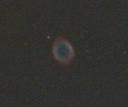After weeks of cloudy days and rainy evenings, I was desperate to start imaging with the modified SPC900 again. We had family over for a meal and with the evening being dry we sat outside to make the most of this British summer! I couldn’t believe there was not a cloud in the sky, perfect viewing conditions and when the conversation turned to looking at the stars I offered to get the scope out and show everyone the rings of Saturn.
I was too late to get Saturn as it ducked down below the neighbours trees, and my hasty setup made the goto less than accurate. I turned the scope to Jupiter but the modified SPC900 didn’t seem to work well in video mode anymore and the picture was breaking up quite badly. I’d also not collimated the scope for some time so when I did get Jupiter in focus there was very little detail visible. This was the first time I’d managed to get Jupiter with the 3x barlow and I was very impressed with the size of the image as displayed on the screen, next time I’ll make sure I have the Trust camera handy.
With a full belly and a beer or two inside me I was ready for my bed when our guests left, but as everything was setup I thought I’d make the most of the weather conditions and spend an hour imaging.
I imaged through the night and only stopped when the sky turned a light blue in the east and dawn was not too far away. I’d been tracking M31 over the roof of my house when I realized the stars were starting to fade into the lightening sky, so after a quick glance at my watch I thought I’d pack up. 
In 5 hours I’d managed to work through a list of Messier objects that I’d prepared for such an occasion and have captured M5, M10, M11, M12, M13, M51, M53, M57, M81, M82, M92 as well as one of my favourite stars Cor Caroli.
Towards the end of the session I picked out a double star in Hercules and was disappointed to find that I really should have taken the time to line up my optics correctly. The double star appeared as two fuzzy points rather than the pin points I was hoping for. I fetched by 3x barlow and laser collimator and performed a quick primary alignment using the barlowed laser method. This is very quick and easy and I was kicking myself that I hadn’t done this earlier. If you haven’t tried it do a quick search on Google for Barlowed Laser  Collimation.
Collimation.
With the primary mirror now pointing in a different direction to where it had been when I aligned the mount, I did another 3 star alignment. What a difference it makes to have everything pointing in the same direction. When I tapped M57 into the hand controller I was amazed to see the Ring Nebula appear just off center on the screen. Awesome. I’d never seen M57 before and had resigned myself to only capturing bright nebula like M42 in Orion.
I’ve got some processing to do now to make the most of the images I captured but a quick look through them seems promising.
I’m not happy with the EQ-6 tracking at the moment, I wasn’t able to capture more than 10 -15 seconds without the stars stretching into ovals so I’ll have to look into how I correct the tracking errors. When I find the answer I’ll post it here.
Update
I’ve just added a Messier Catalogue to the images section, I’ll need to sort out longer exposures before I can fill in the missing M’s.
Update Update
I forgot to say, when I took the mount apart the following morning I found that I hadn’t tightened the bolt that joins the mount to the tripod after I’d adjusted the azimuth alignment. I should be glad the whole lot didn’t fall off the mount rather than worry about a few stretched stars!
